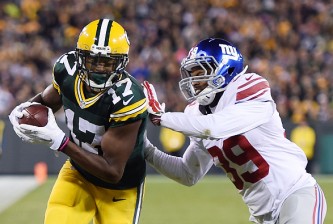I haven’t done a post like this in a very long time. Viewers take watching sports for granted. We watch the games in high definition or some cases, 3-D, get instant replays, we can rewind plays instantly on our DVR’s, know how far a team has to go in order to get a first down, see the score and time as soon as we tune into a contest, get taken to another game if the one we’re watching is a blowout and watch a profile of an athlete to get to know him and/or her better. All of these are standard fare in sports, but at one time, producers needed to think outside the box to make them realities.
Let’s review the five greatest innovations in sports television. You can agree or disagree.
5. “Up Close and Personal”
ABC Sports brought this to fruition for its Olympic coverage. Executive Producer Roone Arledge realized that viewers were not familiar with most of the athletes in the Olympics. To help to get to know them better, Arledge and his ABC Sports producers developed profiles of the athletes to make viewers care about them. They would show the men and women at home instead of training for the Olympics. There would be interviews in relaxed settings. Some would have voiceovers from ABC announcers while others had narration from the athletes themselves. No matter how they were voiced, the profiles served their purpose. Starting with the 1972 Munich Summer Olympics, Arledge titled them “Up Close and Personal.” While English teachers across the country cringed, viewers responded. And the profiles were used by all networks especially when NBC took over the Olympics. While the profiles are rarely used by NBC now, they still bring viewers closer to athletes.
Here’s an example of one ABC Olympics profile from the 1988 Calgary Games. This is of US Men’s Figure Skating Champion Brian Boitano as narrated by Jim McKay. As a bonus, you get a little preview of the “Battle of the Brians” between Boitano and Canadian Brian Orser with McKay and analyst Dick Button.
4. Fox Box
When Fox Sports surprised the sports world and purchased the rights to the National Football League in 1993, snatching them away from long-time incumbent CBS, the network promised to bring a new attitude to the game. They promised to bring younger viewers to the game as the ratings actually skewed to older demographics. And one of the first features people saw when Fox aired its first NFL game was a scorebug in the upper left hand corner of the screen. It was welcomed by fans all over the country. Former Fox Sports El Jefe del Mundo David Hill had brought something similar to English Premier League coverage on Sky Sports in the UK and felt it would work in the NFL. Boy did it ever. Other networks followed. Hill mentioned the Fox Box in the unveiling of Fox Sports 1 in New York, joking that he wished it was called the “Hill Box” instead.
The Fox Box has evolved over the years looking like this in 1994. Looks primitive compared to today.

It’s changed the way we’ve watched sports. Every network has had to develop some type of scorebug. If you look at any sporting event pre-1994, it looks strange not to have a Fox Box.
3. “Whiparound” Coverage
A key for NCAA Tournament coverage, it started either in 1980 on ESPN or in 1981 on NBC depending on which account you want to believe. With most people watching NBC back in the early 1980’s, the Peacock gets most of the credit for bouncing in between three buzzer beaters in the NCAA Tournament with host Bryant Gumbel navigating viewers from St. Joseph’s upsetting DePaul to Arkansas winning over Louisville on the only halfcourt buzzer beater in NCAA Tournament history and finally to Rolando Blackman’s jumper with no time left to steer Kansas State over Oregon State. That is when the Madness was added to March. Here’s the last two buckets of Arkansas-Louisville with Marv Albert on the call for NBC, host Bryant Gumbel is in the middle of the video.
ESPN perfected the format for the NCAA Tournament in the early rounds as it shared the event with CBS from 1982 through 1990. When CBS took over the entire tournament in 1991, it did its best to match ESPN’s whiparound.
ESPN also used the whiparound on its NHL coverage in the 1980’s into the 1990’s and currently uses it on its college football “Goal Line” and college basketball “Buzzer Beater” channels as well as on the NCAA Women’s Tournament. MLB Network also utilizes it on MLB Tonight, but nothing quite matches the whiparound on the NCAA Tournament.
2. 1st and 10 Line

It first debuted on an ESPN Sunday Night NFL Football game in 1998 and was quickly followed by its network TV debut weeks later on CBS on Thanksgiving Day. It was soon standard for every football game both college and pro. It’s mostly yellow, sometimes orange, but yellow has become the best color to stand out on a green field. Other lines are used for the line of scrimmage or to signify a kicker’s field goal range for a game winning score or for an onside kick. No matter the network, the 1st and 10 line has to be included in the game broadcast or it doesn’t feel right.
1. Instant Replay
Where would we be without instant replay? Not only do we want to see a replay on television, but for a controversial play on-site, we want to see it at the stadium. Replay began in 1955 on CBC’s Hockey Night in Canada through a kinescope, but that was only a few minutes after the play was aired. Videotape replay or “instant” replay didn’t occur until 1963 when CBS Sports director Tony Verna invented a system to play back the shot that was just seen during the Army-Navy football game. It wasn’t in slow motion, but it was the first-ever replay of a touchdown in the history of sports television. And soon afterwards, the way we watch sports would change forever.
Replay is used to review calls in the NFL, home runs in Major League Baseball, three point shots in college basketball and the NBA and goals in the NHL. Without replay, games would be be seen and mostly forgotten. Games become memorable with replays. Now we can watch that great catch, that bone crushing tackle, that dramatic home run or that game-winning goal from several different angles. Imagine if Verna hadn’t called for the replay?
Honorable Mentions: Pregame shows, ESPN SportsCenter.
Those are my selections for the greatest innovations in Sports Television.
























